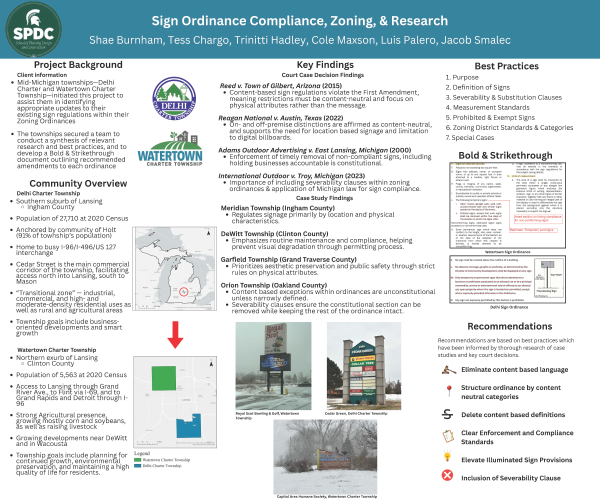
Sign Ordinance Compliance, Zoning, and Research for Delhi and Watertown Townships
DOWNLOADAugust 8, 2025 - Shae Burnham, Tess Chargo, Trinitti Hadley, Cole Maxson, Luis Palero, Jacob Smalec
Sign Ordinance Compliance, Zoning, and Research is a student-led project responsible for examining and enhancing the sign regulations within the Zoning Ordinances of Delhi Charter Township and Watertown Charter Township. This project was led by a team of Michigan State University’s Urban and Regional Planning Program students as part of the Spring 2025 Planning Practicum course. Planning Practicum is a service-learning capstone course that engages students in real-world urban and regional planning projects in collaboration with community partners to provide students with practical experience through applied research, outreach, and hands-on problem solving. The course allows students to apply classroom knowledge to planning challenges while developing professional skills.
While both townships seek to update their zoning ordinances, each community presented challenges that required analyses and recommendations to address specific legal compliance, resulting from the landmark Supreme Court decision Reed v. Town of Gilbert, Arizona (2015). In this case, the Supreme Court ruled in favor of petitioner Pastor Clyde Reed, holding that the town of Gilbert’s sign ordinance, which imposed restrictions on signs based on their message, violated the First Amendment. This case clarified the standard for evaluating sign regulations and the level of constitutional scrutiny that may be applied, reinforcing the principle that regulations must be content-neutral. Content-neutrality refers to regulations that treat all expressions equally regardless of the message or content. It set the bar for government regulations and significantly impacted local sign ordinances across the nation.
This project was completed in two primary sections: research phase and recommendations. Research included field observations along with an in-depth review of relevant court cases and legal precedents to identify legal vulnerabilities. Legal frameworks, particularly those dealing with the First Amendment and Michigan decisions, were reviewed to assess compliance. In addition to Reed v Town of Gilbert, Arizona, the team examined three other decisions to gain a better understanding of how Reed has been interpreted and applied in real-world scenarios since the decision.
In Adams Outdoor Advertising v. City of East Lansing (2000), if an owner of a sign does not bring said sign into compliance within a timely manner, the municipality may remove the sign with no consequence. This local Michigan case sets the precedent and provides guidance on how to enforce the removal of non-compliant signage by setting a timeline for the enforcement of new sign ordinances.
In Austin, Texas v. Reagan National Advertising (2022), the Supreme Court clarified the meaning of content-neutrality in the context of on-/off premise distinctions. The court ruled that the requirement to read the sign does not inherently trigger strict scrutiny, rejecting the so-called “read-the-sign rule,” shifting the legal landscape and offering some flexibility for municipalities. This case serves as a guide for the limitations of regulating signage while upholding content-neutrality.
Finally, International Outdoor v. City of Troy (2023) provided guidance on local government permitting systems. The decision gives municipalities the jurisdiction to sever content-based exceptions to permit requirements; and provides insights into the regulations regarding billboard advertising.
The team drew additional insights from other Michigan communities, including Meridian Township, DeWitt Township, Garfield Township, and Orion Township, and from the Michigan Municipal League Capital Sign Conference in 2016. All research done contributes to the following components of best practices: clear purpose alignment, content-neutral definitions, clear severability & substitution clauses, clear standards for measuring sign dimensions, clear prohibited and exempt signs, broad content-neutral categories organized within zoning districts, and special concerns around digital signs and recent case laws.
In Delhi Charter Township, the sign ordinance was found to contain limited content-based definitions, content-based regulations, and formatting inconsistencies. Recommendations to mitigate noncompliance consisted of transitioning to content-neutral language, eliminating and simplifying content-based definitions, and structuring the ordinance by physical attributes (e.g., permanent, freestanding, wall-mounted, ground signs). In addition, severability and substitution clauses could be added. Both clauses will ensure that the ordinance has continued validity, even if some provisions are considered invalid by a court.
In Watertown Charter Township, officials expressed concerns about digital signage and the impact of illumination. The ordinance is structurally consistent, organized primarily by physical characteristics, with temporary signs governed by more strict provisions that could be perceived as overly restrictive. To mitigate potential issues and enhance clarity, it is recommended the township introduce a new section on illumination. This section would provide for more detail on physical criteria, such as brightness, display duration, motion, flashing, etc., tailored to zoning districts. Next, extra care should be taken into consideration with temporary signage and this category should communicate necessary regulations without prioritizing certain signs based on their content.
The Sign Ordinance Compliance, Zoning, and Research report provided both Delhi Charter Township and Watertown Charter Township with tools to improve their signage section within their Zoning Ordinance. The resulting “Bold & Strikethrough” drafts offer a revised, and enforceable framework for sign regulation. A key component of this effort involved the elimination of content-based language that was replaced with content-neutral language focused on physical attributes such as location. For example, one definition that was removed read: “Political signs: A temporary sign used in connection with an official city, village, township, school district, county, state, or federal election, referendum, or public issue." By grounding recommendations in physical attributes, both townships are equipped to better manage signage to promote safety, aesthetics, and address local concerns.



 Print
Print Email
Email




